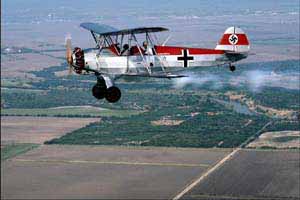Focke-Wulf Fw 44C Stieglitz
German Trainer
 |
The Ghost Squadron's Fw 44C Stieglitz. Image source: The Confederate Air Force Ghost Squadron CD-ROM produced by Corel. Photos by Bill Crump. |
Originally designed as a two-seat civilian biplane for pilot training and sport flying, the Stieglitz (German for Goldfinch) prototype first flew in 1932. After test and modifications to increase the plane's strength and improve its flight characteristics, the final Fw 44 design proved to have excellent maneuverability and aerobatics capabilities.
Famous German pilots of the 1930s including Ernst Udet, Gerd Achgelis and Emil Kopf all flew the Stieglitz in aerobatic displays and air shows in Germany, and flight schools and flying clubs placed orders for the new plane in large numbers. The demand was so great that Focke-Wulf opened a new factory just to build the Stieglitz. Orders also came from a dozen other countries and in some, Fw 44s were produced under license.
A second version of the design was the Fw 44B, which used an Argus As 8 four-cylinder inverted inline air-cooled engine of 120 horsepower. This gave the plane a more slender, aerodynamic nose that the bulkier Siemens radial engine. This model was produced in limited numbers and followed by the Fw 44C. The final C model was powered by the Siemens radial engine and was produced in the largest numbers.
With a fuselage of welded steel-tube and wings of wooden spars and ribs, the Stieglitz design was fabric covered with metal panels behind the engine. The two cockpits were open, with the pilot or student pilot flying from the rear cockpit and a passenger or instructor in front.
The Fw 44 was used by Luftwaffe training units all through the Second World War, and probably every German pilot flew the Stieglitz at some time in his training or flying career.
Specifications
Pilot and Passenger/Instructor One Siemens Sh 14a Engine Max. Speed 115 mph @ sea level Climb to 9,840 ft in 23.6 minutes |
Length 23' 11" Max. Weight 1,985 lbs Normal Range 420 miles |